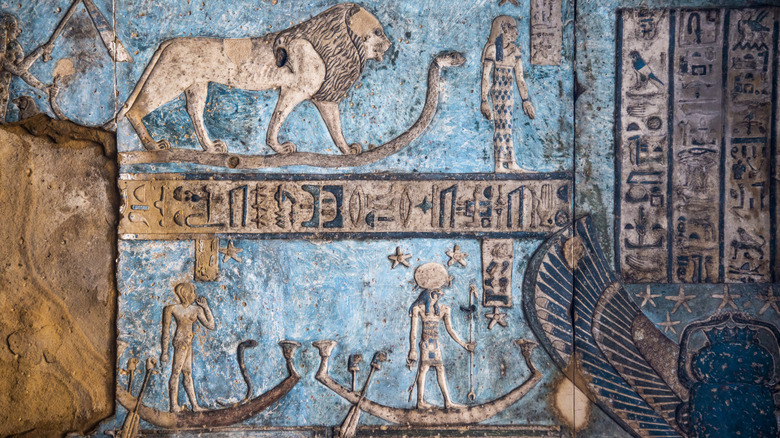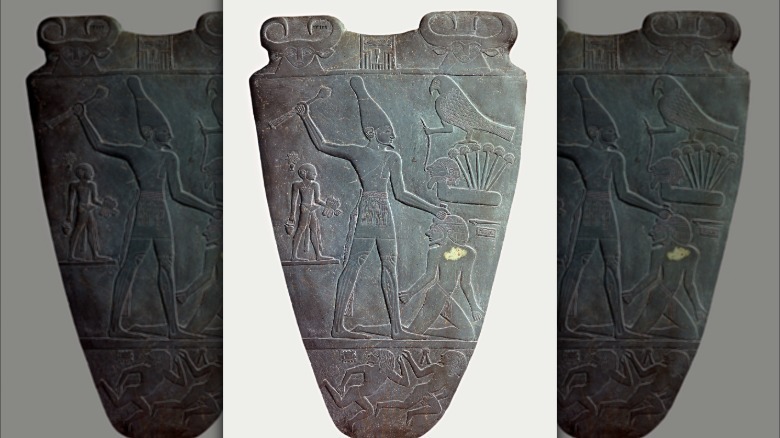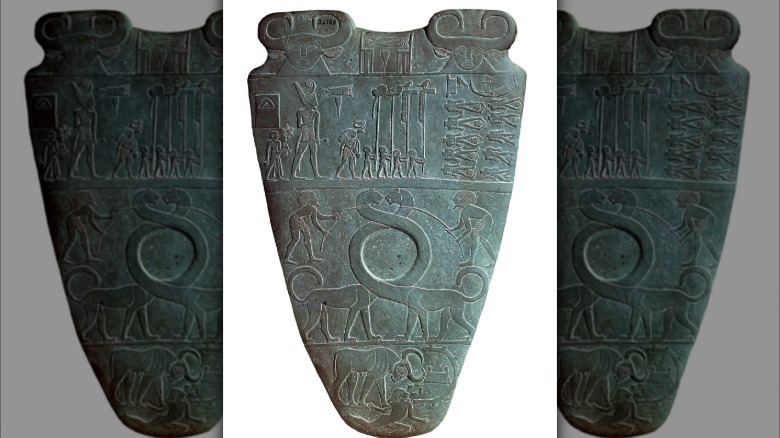This Is Who Experts Believe Was Egypt's First Pharaoh
The history of Egypt's pharaohs and culture still looms large in modern culture. The ancient civilization's tombs, pyramids, and artwork continue to spark curiosity about life on Earth thousands of years ago, and much about it still can't be explained. The first dynasty began around 2900 B.C., and in this time period, Upper and Lower Egypt were ruled by one person. Prior to that unification, those regions considered themselves separate entities. History shifted though when one man managed to pull the North and South of Egypt together — or maybe it's more accurate to say he coerced them together. It's not fully known how he did it.
The credit for that feat goes to Egypt's first king, Narmer. While we're used to Egyptian rulers being called pharaohs, it wasn't until the New Kingdom, which began with the 18th dynasty, that those leaders were referred to as such. While there is very little record of Narmer since he lived a cool 5,000 years ago, most historians agree at this point that he was the person who unified Upper and Lower Egypt and went on to rule them as one nation. For a while, it was believed someone named Menes was the person who united Egypt's two regions, and that he and Narmer were two different people. Today, it's accepted that those people were one and the same. Narmer was the first king's birth name, while Menes was an honorific name, kind of like how the pope changes his name when he is elected.
The Narmer Palette offers clues
In predynastic Egypt, there was already a lot going on in the bustling civilization. In The Collector, historian Sebastián Maydana describes a land that's no stranger to conflict, made evident from ancient skeletal remains, weapons, and "iconographic evidence" like the Narmer Palette, a 2-foot-tall gray siltstone slab. It's the primary source for decoding Narmer's conquest and subsequent rule. Narmer's Egypt already had trade routes established that went as far as modern-day Cyprus and Afghanistan. They traded things like pottery, honey, and beer for ivory, animal pelts, wine, and gold. Archeologists found what they believe to be the world's first zoo in Upper Egypt as well as the first observatory, where they studied the stars in an effort to optimally plan their activities like herding, sort of like an ancient Farmer's Almanac.
Not a lot is known about Narmer's early life, but he's believed to come from the city of Hierakonpolis. How he came to be Egypt's first ruler isn't fully understood, but the Narmer Palette gives clues. British archaeologists discovered the stone in the late 19th century during a dig at the ruins of the Temple of Nekhen, not far from Hierakonpolis in Upper Egypt (known as Nekhen in ancient times). The two-sided artifact was made circa 3200 to 3000 B.C. and depicts King Narmer wearing the crown of Lower Egypt on one side and the crown of Upper Egypt on the other. The pictures symbolize the union of the regions under one rule — the first time that a king wearing both crowns has appeared in a single piece of ancient Egyptian art. What's not known for certain is if the depictions were realistic or a bit of old-school propaganda.
Narmer ruled for at least 30 years and his son succeeded him
On one side, the Narmer Palette depicts the king holding a man by the hair as he prepares to hit him with a mace. The other side shows the pharaoh as a much larger figure than any of the others surrounding him. He and his army stand before rows of decapitated people in what is said to be a battle scene. Anyone who sees it might think that Narmer came to power by his military might, but the Rosicrucian Egyptian Museum says that he took power peacefully. According to EBSCO, the artworks might have been intended to promote this alleged peaceful unification and bolster his rule.
Another artifact from the pharaoh's reign is the Narmer macehead, which was made to commemorate 30 years of his rule. The celebration that came with that anniversary, called "Heb-Sed," was a tradition that pharaohs continued for thousands of years. Narmer was believed to have been married to a woman called Neithhotep, who some say was a princess in Lower Egypt, thereby symbolically deepening the union between the Northern and Southern regions. Hor-Aha, the couple's son, was the second ruler of Egypt. It's not known for sure how Narmer died, but long after his reign, it was written that he was killed by a hippopotamus, though National Geographic says that could have just been "a figure of speech."
His tomb was nothing like the elaborate resting places of the later pharaohs. Located in southern Egypt, it consists of two rectangular underground chambers, one smaller than the other. Bricks made of mud line the walls, and according to The Ancient Egypt Site, the holes in the ground were "cut." There is also evidence that a roof once covered the grave.


